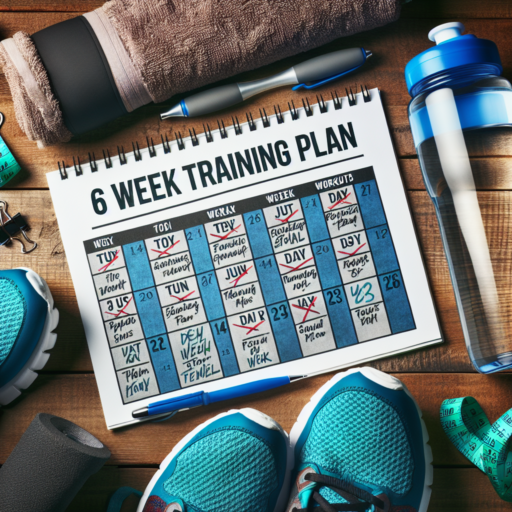No se han encontrado productos.
Can I get in shape in 6 weeks?
The question of whether one can get in shape in 6 weeks is a prevalent one, with many individuals seeking quick, effective methods to improve their fitness levels and overall health. The answer, while not straightforward, points toward a positive outlook with the right approach and adherence to a well-structured plan.
Understanding body transformation within such a short period is essential. It involves not just weight loss but enhancing muscle tone, stamina, and overall well-being. A six-week timeline necessitates commitment to both diet and exercise, with a focus on consistency rather than perfection. Achieving noticeable results in this timeframe is possible, but it requires dedication to a comprehensive fitness regimen.
One vital aspect to consider is the personal starting point. Individuals starting from a lower level of fitness may see more dramatic results initially due to their bodies’ adaptation to new physical activities. Conversely, those with a higher baseline of fitness might find improvements more subtle. Regardless, setting realistic goals is crucial to not only measure progress but to maintain motivation throughout the six weeks.
Can I train for a 5K in 6 weeks?
Embarking on a 5K run is a fantastic way to challenge yourself, boost your fitness levels, and achieve personal milestones. A common question among beginners and seasoned runners alike is, «Can I train for a 5K in 6 weeks?» The short answer is, yes, with the right approach and dedication, it’s entirely possible to prepare for a 5K run in this timeframe.
Training for a 5K within six weeks requires a structured plan that gradually increases in intensity and volume, allowing your body to adapt without risking injury. It’s important to start where you are, fitness-wise, and progressively build up your endurance and speed. A balanced training program should include a mix of running, walking, rest days, and maybe even some cross-training to improve overall fitness and prevent burnout.
Key Components of a 5K Training Plan
- Frequency: Aim for 3 to 4 run sessions per week. This ensures adequate progression and recovery.
- Intensity: Include a variety of workouts such as easy runs, interval training, and long runs to boost your performance.
- Rest and Recovery: Incorporate at least one complete rest day per week to allow your body to recover and grow stronger.
Listening to your body throughout the 6-week period is crucial. While pushing yourself can lead to gains in speed and endurance, ignoring signs of fatigue or discomfort can lead to setbacks. Importantly, while a 6-week training plan is relatively short, it’s essential to set realistic goals based on your current fitness level and experience. With commitment, a properly structured training plan, and a focus on incremental improvement, reaching the finish line of your first 5K is an achievable goal.
How do I make a 6 week fitness plan?
Creating a 6-week fitness plan requires a personalized approach to meet your individual fitness goals, whether it’s losing weight, building muscle, or improving endurance. To embark on this transformative journey, begin by assessing your current fitness level and setting realistic goals. This initial step ensures the plan is tailored to your abilities and ambitions, paving the way for measurable progress and sustained motivation throughout the six weeks.
Establish your fitness goals: Clearly define what you aim to achieve within the six-week timeframe. Be specific, measurable, attainable, relevant, and time-bound (SMART goals). Whether it’s enhancing cardiovascular health, gaining strength, or achieving a combination of goals, a clear direction will guide your plan’s structure and workout selection.
Develop a balanced routine: A comprehensive fitness plan includes a mixture of cardiovascular exercises, strength training, flexibility workouts, and ample rest days. Incorporate a variety of activities to keep the program engaging and cover all aspects of fitness. For instance, dedicate certain days to cardio exercises such as running or cycling, others to strength training like weight lifting or bodyweight exercises, and intersperse these with yoga or stretching sessions for flexibility and recovery.
How to get ripped in 6 weeks?
Achieving a ripped physique in just 6 weeks is a challenging but attainable goal, requiring strict dedication to both diet and exercise. The key is to focus on high-intensity interval training (HIIT) to maximize fat burn and incorporate strength training to build lean muscle. Below, we delve into essential strategies to help you sculpt your body efficiently within this tight timeframe.
Optimize Your Diet
First and foremost, your diet plays a pivotal role in getting ripped. Concentrate on eating a high-protein, low-carb diet to fuel muscle growth and aid in fat loss. Incorporate lean meats, fish, vegetables, and healthy fats into your meals. It’s also crucial to maintain a caloric deficit—consume fewer calories than your body burns. However, ensure it’s not too steep to avoid losing muscle mass. Keeping yourself hydrated and avoiding processed foods and sugars are non-negotiable rules during these 6 weeks.
Intensify Your Workouts
Commit to a rigorous workout regimen that combines HIIT with strength training. HIIT sessions, known for their fat-torching capabilities, should last between 20 to 30 minutes and be performed three times a week. On alternate days, focus on compound exercises like squats, deadlifts, and bench presses to build strength and muscle across major muscle groups. Incorporating bodyweight exercises, such as push-ups and pull-ups, can further enhance muscle definition. Consistency and progressively increasing the intensity of your workouts are crucial for achieving noticeable results.
Rest and Recovery
Last but not least, allowing your body ample time to recover is essential for muscle growth and overall performance. Ensure you get at least 7-8 hours of sleep per night and consider incorporating active recovery days into your regimen. Simple activities like walking or yoga can aid in muscle recovery and flexibility, reducing the risk of injury. Remember, while the goal is to get ripped, listening to your body and not overtraining is paramount to your health and success in this journey.




